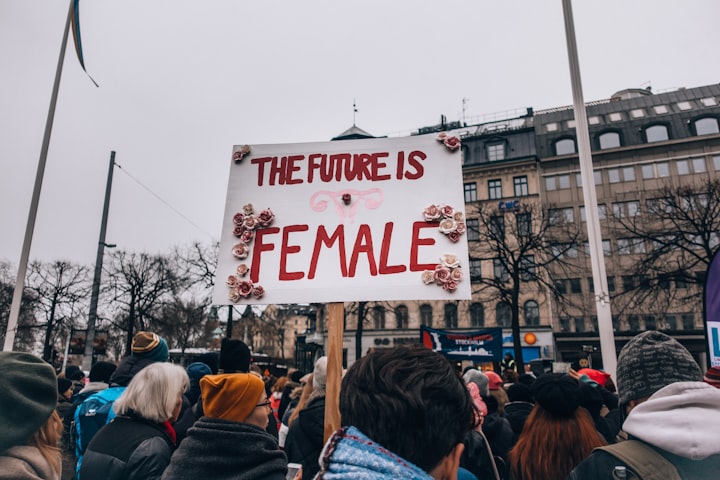Exile, Erasure, and Embodiment: A Retrospective Reconfiguring of the Works of Ana Mendieta
Art History and Feminism

In 2018, the New York Times ran an electronic obituary entitled, “Overlooked No More: Ana Mendieta, A Cuban Artist Who Pushed Boundaries”. Directly below the title is a black and white photograph of a woman with long dark hair, her face dappled with sunlight, her eyes unfocused. Under that, is printed the diminutive italicized disclaimer, “Since 1851, obituaries in The New York Times have been dominated by white men. With Overlooked, we’re adding the stories of remarkable people whose deaths went unreported in The Times.” For reference, Ana died in 1985. Her husband at the time, the evidently more preeminent minimalist sculptor Carl Andre, explained to emergency services that they had been fighting when suddenly she had “somehow gone out of the window” of their 34th floor apartment in Greenwich Village. She was thirty-six.
Heroism comes in many forms. Hers, it seems, was as much spiritual and feminine as it was artistic.
Artists leave their own eulogies, I suppose, and some are more uncanny than others. I am thinking now of Mendieta’s Silueta Series. In each piece, Mendieta utilizes the shape and contours of her own body, or else its radical absence and impression, couched upon the natural landscape in the attempt to create an alchemical fusion between the two. In her first Silueta work, Ana reclines nude in a Zapotec tomb, her body covered in delicate white blossoms, positioned to appear as though the blooms are sprouting out of her. Immediately one kind of infinity is established in the form of this circularity: from the symbolic and actual site of death emerges an impulse towards existence and connection, in the form of miniature florets darting up from the artists’ own stationary physicality.
In other photographs, the body is conspicuously “missing” although its crude, suggestive outline remains in sand, sticks, or shadows. The viewer recognizes the visceral delineation of a human form—but to whom that form belongs—whether they are man or woman or neither, old or young—is purposefully equivocal. Despite the aesthetic lushness underlying every site, Mendieta’s works intuitively draw a line of connection between femininity and absence. Immediately, instinctively, we understand these outlines encompass the implication of violence and subsequent trauma—a void-like potentiality that is indelibly intertwined with notions of the embodied feminine. There is, for instance, the way that the rough profile of the human body is scalded into the still-damp sand of a nameless beach in Silueta Works in Mexico, cut like a wound from the earth itself.
In her provocative work Females (2019), Andrea Long Chu offers this contentious assertion: “Everyone is female, and everyone hates it." Chu defines femininity not as a set of physical characteristics, but rather as a kind of existential state understood primarily in relation to the female’s sublimation of the self, or radical self-negation. The feminine body, which is understood to be universal, may then be identified by its absence before ‘the other’, and in the ways that any native desire is necessarily evacuated in relation to the masculine. The Silueta Series undoubtedly exists as a commentary on the feminine, but it may be reductive to confine these images to discussions of merely absence or evacuation. Mendieta effortlessly straddles the macabre of the absent body and the haunting that such a lack implies, and the vivacity of the natural world that continues on around it, not quite impassively. Each piece suggests an inherent extrapolation in which the feminine might logically extend, or be exploded to encompass the earth itself.
Mendieta conceived the idea for the Silueta Series while traversing pre-Columbian sites in Mexico. Born to a prominent politician and a chemistry teacher in Cuba in 1948, Ana and her sister, Raquel, were sent by their parents to the United States in 1960. In the next few years, the girls were ushered through a series of group and foster homes. It is not so surprising then that setting and atmosphere consistently played such a pivotal role in Ana’s works, given that so much of her life was spent in exile and upheaval. Fervent in her appreciation of the occult and ritualistic traditions of her native Cuba, and the Indigenous and Caribbean practices she found in Oaxaca, Mendieta’s pieces rejected the static, linear expectations that pervade much of modern western art. Each Silueta is a dynamic, uncertain thing—a self-portrait imbued with sophisticated ecological and cultural consciousness—a return to the ancient as a means of understanding the timelessness of certain embodied truths. The Siluetas are a study in contradiction: in their refusal to clearly acknowledge a human subject, every vacant outline implies just that. In the introduction to her work Femme Fatales: Feminism, Film Theory, and Psychoanalysis, Mary Ann Doane describes the feminine as an occasional, “figure of a certain discursive unease, a potential epistemological trauma… She harbors a threat which is not entirely legible, predictable, or manageable.” Indeed, an additional layer of secrecy is granted to the Siluetas by virtue of the ephemerality of the settings themselves. Because each site is reliant upon palpable, volatile forces like the turbulent ocean tides or the ominous flickering of a recently lit fire, the subsequent art is marked by gradual variations of temporal chaos.
Ana’s early works are characterized by an interest in adding to the dialogue that existed around not only female sexuality and empowerment, but also the existence of pervasive violence against women. Ralph Rugoff, the artistic director of Hayward Gallery in London, explains that Mendieta vacillated “nomadically across practices associated with body art, land art, performance, sculpture, photography and film.” The accessibility and dynamism of performance art generally, and film in particular lent itself to the artist’s vision. In Untitled (Glass on Body Imprints), Mendieta positioned sheets of transparent plexiglas upon her nude body to comment upon the objectification of the female form—each imprint is subsequently rendered almost absurd in its reductive and poetical dislocation.
In response to a brutal nearby rape and murder, and as an extension of these previous artistic sentiments, Mendieta would stage her Rape Piece in front of friends and acquaintances at the University of Iowa in 1972. In photographs of the scene, Mendieta is bent at a cruel angle over her kitchen table, naked from the waist-down and splattered with blood. Later, she would enact similar scenes in various outdoor campus locations. In her book Where is Ana Mendieta? Jane Blocker understands the staging as a complex commentary upon female desire as well as non-consensual violence perpetrated upon the female form. She expounds, “Just as it is inconceivable [to certain critics]… that Mendieta would desire to touch instead of be touched, that her sexuality could exceed passivity, so it is impossible to imagine nature as desirous, sexual, and aggressive. Mendieta’s earthworks have consequently been as misunderstood as her body art.” To be sure, there is nothing passive about Mendieta’s performances. Not even the impossible stillness bestowed by the immortalization of a camera flash could render any one of the Siluetas static. Perhaps this is what makes her death, as Andre described it to the emergency telephone operator, feel so deeply alien and unlikely. The vibrancy and dynamism of Ana’s Siluetas directly contradicts the amorphous, yielding image that is evoked with the line that she “somehow went out of the window.”
Ana was thirty-six when she died. In 1992, when Mendieta would have been forty-four, the Guggenheim put one of its inaugural shows, featuring a host of works by Carl Andre, and none by his late wife. A maelstrom of feminist protestors waving banners emblazoned with the question “Where is Ana Mendieta?” interrupted the celebration. When The Times finally got around to publishing her obituary in 2018, she would have been seventy. The years following Mendieta’s sudden death unfurl in a series of pivotal moments such as these: like snapshots surrounding an absence. How does one begin to talk about a lost and absent thing? Ana Mendieta offers us this much in her Siluetas: haunting requires a body. Consider the refrain of Mendieta’s own human outline in tree boughs, ice, and dirt-- the ways she, and her antithesis, are implicated in site after luminous site. It is for this reason that physicality and any art that seeks to represent it, will be in some ways illegible and inscrutable—circumscription implies hollowness. In a sense, the body, for Mendieta, becomes a repository for everything we cannot think but are condemned to feel.
We know these kinds of truths because of Ana Mendieta—intimate, revealing, calamitous unconscious truths that might never be effectively articulated. After all, the power as well as the peril of the visual is that the initial perception of a piece frequently bypasses conscious thought entirely. For better or for worse, the image is generally subsumed holistically, with a radical immediacy that only reveals the extent of its infiltration upon later reflection. Her earth works might very well be internalized instinctually into our own bodies in the way that great art frequently is--but even so, we still ask, “Where is Ana Mendieta?”
For it seems unlikely at worst, and reductive at best, to say that she is dead.
Works Cited
Blocker, J. (2012). Where Is Ana Mendieta? Identity, Performativity, and Exile. Durham: Duke University Press. Castillo, M. (2018, September 19). Overlooked No More: Ana Mendieta, a Cuban Artist Who Pushed Boundaries. Retrieved September 21, 2020, from https://www.nytimes.com/2018/09/19/obituaries/ana-mendieta-overlooked.html Chu, A. L. (2019). Females. London: Verso. Doane, M. A. (1991). Femmes fatales: Feminism, film theory, psychoanalysis. New York: Routledge. O'Haggan, S. (2013, September 21). Ana Mendieta: Death of an artist foretold in blood. Retrieved September 21, 2020, from https://www.theguardian.com/artanddesign/2013/sep/22/ana-mendieta-artist-work-foretold-death Silueta Works in Mexico. (n.d.). Retrieved September 21, 2020, from https://www.icaboston.org/art/ana-mendieta/silueta-works-mexico
About the Creator
Katie Alafdal
queer poet and visual artist. @leromanovs on insta






Comments
There are no comments for this story
Be the first to respond and start the conversation.